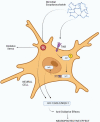Revisiting microbial exopolysaccharides: a biocompatible and sustainable polymeric material for multifaceted biomedical applications
- PMID: 38449708
- PMCID: PMC10912413
- DOI: 10.1007/s13205-024-03946-3
Revisiting microbial exopolysaccharides: a biocompatible and sustainable polymeric material for multifaceted biomedical applications
Abstract
Microbial exopolysaccharides (EPS) have gained significant attention as versatile biomolecules with multifarious applications across various sectors. This review explores the valorisation of EPS and its potential impact on diverse sectors, including food, pharmaceuticals, cosmetics, and biotechnology. EPS, secreted by microorganisms, possess unique physicochemical properties, such as high molecular weight, water solubility, and biocompatibility, making them attractive for numerous functional roles. Additionally, EPS exhibit significant bioactivity, contributing to their potential use in pharmaceuticals for drug delivery and tissue engineering applications. Moreover, the eco-friendly and sustainable nature of microbial EPS production aligns with the growing demand for environmentally conscious processes. However, challenges still exist in large-scale production, purification, and regulatory approval for commercial use. Advances in bioprocessing and microbial engineering offer promising solutions to overcome these hurdles. Stringent investigations have concluded EPS as novel sources for sustainable applications that are likely to emerge and develop, further reinforcing the significance of these biopolymers in addressing contemporary societal needs and driving innovation in various industrial sectors. Overall, the microbial EPS represents a thriving field with immense potential for meeting diverse industrial demands and advancing sustainable technologies.
Keywords: Biopolymers; Drug delivery; Microbial exopolysaccharides; Sustainable polymer; Tissue engineering.
© King Abdulaziz City for Science and Technology 2024. Springer Nature or its licensor (e.g. a society or other partner) holds exclusive rights to this article under a publishing agreement with the author(s) or other rightsholder(s); author self-archiving of the accepted manuscript version of this article is solely governed by the terms of such publishing agreement and applicable law.
Conflict of interest statement
Conflict of interestThe authors declare that there is no conflict of interest.
Figures







Similar articles
-
Microbial exopolysaccharides: Classification, biosynthetic pathway, industrial extraction and commercial production to unveil its bioprospection: A comprehensive review.Int J Biol Macromol. 2025 Mar;297:139917. doi: 10.1016/j.ijbiomac.2025.139917. Epub 2025 Jan 15. Int J Biol Macromol. 2025. PMID: 39824430 Review.
-
Extracellular polymeric substances of bacteria and their potential environmental applications.J Environ Manage. 2014 Nov 1;144:1-25. doi: 10.1016/j.jenvman.2014.05.010. Epub 2014 Jun 6. J Environ Manage. 2014. PMID: 24907407 Review.
-
Engineering strategies and applications of cyanobacterial exopolysaccharides: A review on past achievements and recent perspectives.Carbohydr Polym. 2024 Mar 15;328:121686. doi: 10.1016/j.carbpol.2023.121686. Epub 2023 Dec 14. Carbohydr Polym. 2024. PMID: 38220318 Review.
-
Mechanism and application of bacterial exopolysaccharides: An advanced approach for sustainable heavy metal abolition from soil.Carbohydr Res. 2024 Oct;544:109247. doi: 10.1016/j.carres.2024.109247. Epub 2024 Aug 22. Carbohydr Res. 2024. PMID: 39180879 Review.
-
Bacterial extracellular biopolymers: Eco-diversification, biosynthesis, technological development and commercial applications.Int J Biol Macromol. 2024 Nov;279(Pt 3):135261. doi: 10.1016/j.ijbiomac.2024.135261. Epub 2024 Sep 5. Int J Biol Macromol. 2024. PMID: 39244116 Review.
References
-
- Agrawal K, Ruhil T, Gupta VK, Verma P. Microbial assisted multifaceted amelioration processes of heavy-metal remediation: a clean perspective toward sustainable and greener future. Crit Rev Biotech. 2023;2023:1–19. - PubMed
-
- Ahmad MF, Ahmad FA, Khan MI, Alsayegh AA, Wahab S, Alam MI, Ahmed F. Ganoderma lucidum: a potential source to surmount viral infections through β-glucans immunomodulatory and triterpenoids antiviral properties. Int J Biolog Macromol. 2021;187:769–779. doi: 10.1016/j.ijbiomac.2021.06.122. - DOI - PubMed
Publication types
LinkOut - more resources
Full Text Sources

